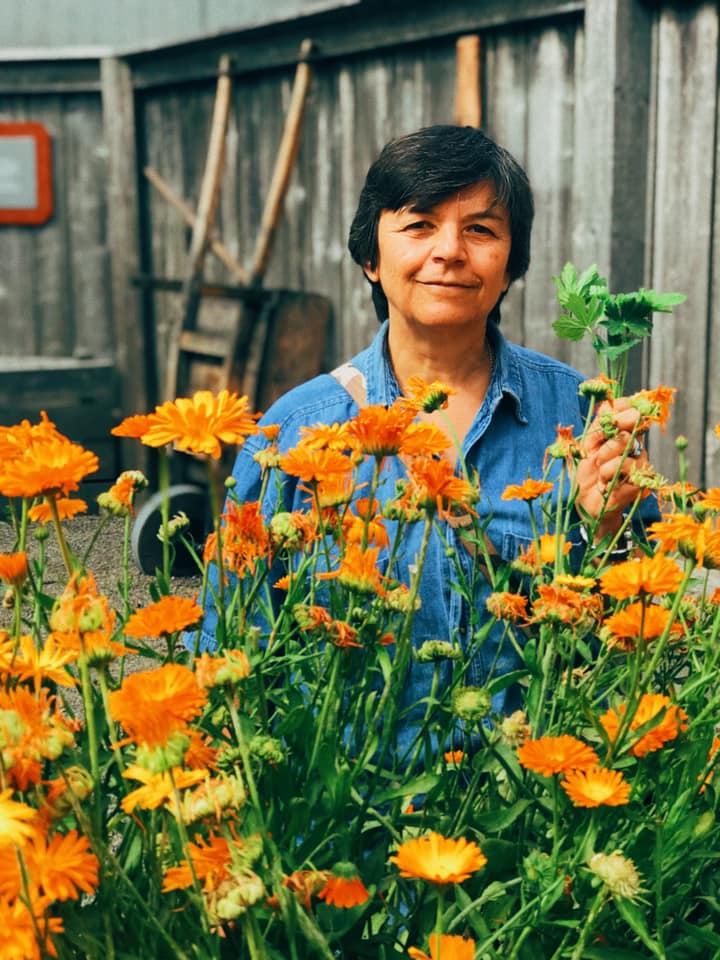
It's been a while since our last Woman of the Week, so we are extra pleased to present Tatiana NIkolova-Houston! Tatiana is an artist, an iconographer, a conservator, and an information scientist. We asked her to tell you about herself:
"Being raised and nourished in the Orthodox Church, iconography and manuscript illuminations have influenced my artistic path and provided me the spiritual strength to survive the challenges of life. I was born in Bulgaria, and my father, a self-taught artist and theatre director, inspired my love of the arts. I received the M.S. in Landscape Architecture in Bulgaria, where I designed parks and spaces for recreation and meditation. The collapse of the communist regime in 1990 enabled me to come to America, where I married and received Bachelor's and Master’s degrees in Religious Studies and Library and Information Science. The pinnacle of my academic career was the study and preservation of the South Slavic (Bulgarian) medieval manuscripts at the Historical and Archival Church Institute in Sofia, which led to my dissertation revealing "the secret history" of the Balkans during the Ottoman rule (1393-1878), as evidenced by manuscript marginal writings. The hand of God has always guided me in the unexpected turns of my life path.
"Since 2008, I have dedicated my life to re-creating and re-interpreting Byzantine and South Slavic iconography and manuscript illuminations as a ministry and mission to Western audiences. Sacred Illuminations grew out of my fascination with Slavic manuscripts, unique in their eclectic decorations inspired by Byzantine arts, Persian carpets, Bulgarian folk arts, and even Celtic designs. The illuminations reflect the joy of spirituality and provide a glimpse of the Heavenly reality, of the radiance of the Holy Spirit within everything in God’s Creation and the spiritual symbolism of Holy Scripture.
"I was trained in formal iconography. Now, I write my icons with gold and metallic pigments and adorn them with Swarovski crystals to resemble in style the ancient Egyptian Christian arts. Iconography is an important spiritual discipline for me, especially during Lent and the fasting seasons, times of intensive prayer. My icons became healing prayers during family hardship and challenges. The pandemic inspired three icons of Christ and the Holy Theotokos. They became my prayers for healing and heavenly protection. The Holy Protection of the Theotokos holding a veil of protection was inspired after the vigil led by Mount Athos monks against the pandemic. Christ - the Lover of Humankind icon encourages us to “Love one another as I have loved you.” The icon came as a response to the divisions within American society into partisan camps: right versus left, right versus wrong, Republican versus Democrat, rich versus poor, us versus them after the George Floyd’s murder.
"My father’s illness and passing in 2010 became the transformative event in my artistic style. Back then, I reversed from black on white to gold on black, a process resembling the "dark night of the soul," utilizing the power of the negative space. The new illuminations grew spontaneously from the center, as if from the heart, laying down layers of gold ink, metallic acrylic, and finally highlighted with crystals. Since then, they have evolved from gold on black to other metallic pigments including silver, blue, purple, and green, and recently pearly, iridescent, and interference acrylic paints to envision the deeply rich and enlivened colors in Heaven. The piece “The Tree of Life – Holy Spirit,” was created as my father was dying. The Tree grew gradually from the central trunk to become an altar, then candelabra, and then into branches pointing upward and nestling the Holy Spirit. The Spirit, as a Dove of Peace, pollinates symbolically the blossoms to become the fruits of the Spirit. My father saw it and blessed me before his death.
"A primary goal of my work is to create beautiful calligraphy of Holy Scripture and prayers of the Church. My humble art ministry attempts to spread the Word of God, and at this time I have inscribed about a hundred Scriptural texts and prayers. Sacred Illuminations continues the legacy of the ancient manuscript scribes, to create new vessels for the everlasting Word of God out of the depths of our rich spiritual heritage. Sacred Illuminations illuminates the mind and the heart and bring us into union with God and each other by spreading the message of peace, wisdom and love. Sacred Illuminations is also a ministry of charity. A percentage of its modest earnings are donated to those in need, such as people suffering in the Middle East, orphanages in Kenya, and homeless people in the US.
"For more examples of my work, visit my website: Facebook art page Sacred Illuminations and my website."
Axia!
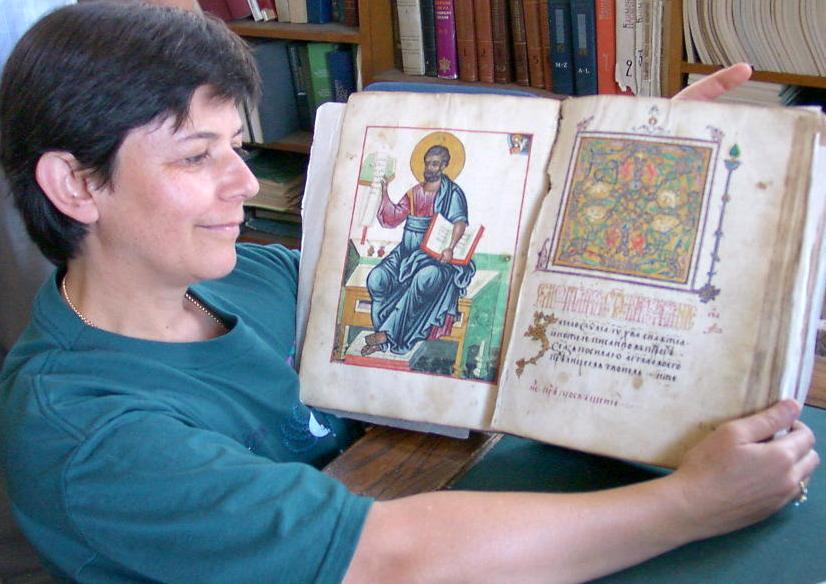
Our Woman of the Week, Tatiana Nikolova-Houston, spent many years working with manuscripts at a remote Bulgarian monastery. One of the things she learned from that years-long project had to do how to become like a medieval scribe. We asked her to tell you about that:
"Discovery is a journey from revelation to revelation. Studying Slavic manuscripts and icons revealed God and my faith to me.
"God led me to America in 1990. I built a family, started a new career, and earned advanced degrees. My dissertation explored medieval manuscripts - the predecessors of the printed Bible that we hold in our hands today.
"Christopher de Hammel's History of Medieval Manuscripts inspired me. The gold and silver illuminations illuminated my soul. What dedication and selflessness did scribes have! What a harmony of the Word of God with the beauty of illumination.
"My first encounter with the manuscripts was a total surprise! No gold or vivid colors. Just simplicity and balance between words and images. The degradation, however, appalled me. These giants of the human spirit had become orphans, covered with dust, pierced by insects, dismembered and undressed from their precious covers. I promised God to make them visible again to the world.
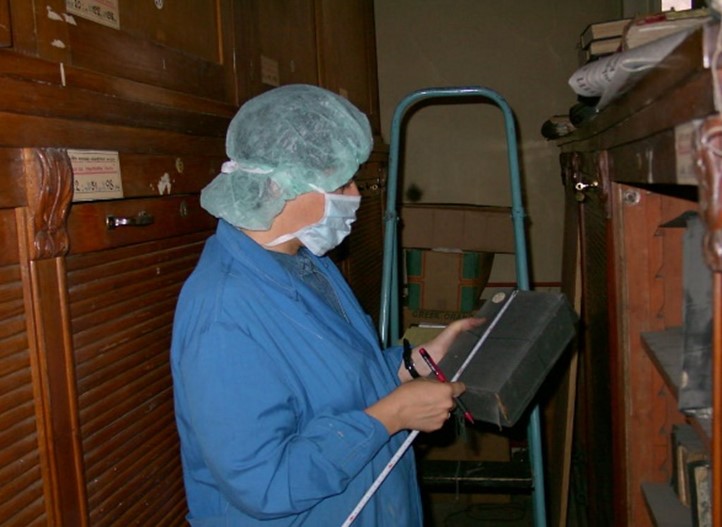
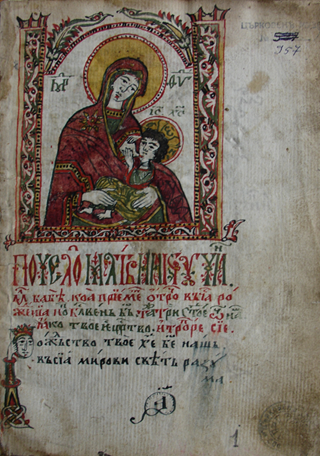
"Approximately 5% of early Slavic manuscripts have survived foreign invasion and neglect. Roughly 8,500 manuscripts survive in Bulgarian collections. I chose the 1,500 manuscripts in Church archive in Sofia. I gave them a computer, scanner, and digital camera, and they allowed me to document the collection, page by page, fighting the black dust of ages. Almost all of them required special care. The Order of St. Ignatius gave me $10,000 for this project, which succeeded.
"Before the Ottoman invasion in 1393, Bulgarian manuscripts were more artistic than their Western counterparts. But the Ottomans prohibited schools and writing materials among Christians, so Slavic manuscripts after 1393 pale in comparison to Western manuscripts such as the Book of Kells. All, however, have value. De Hamel warned us about the dangers of manuscript elitism: '[We] cannot explore a mountain range by looking only at the peaks.'
"Value rests beyond aesthetics if we view from God's perspective. Value rests on a holistic comprehension of texts, images, and historical marginalia, the notes written in the margins. Elaborate or simple, manuscripts tell us stories of human suffering. Michael Camile wrote: 'every book is a relic of bodily pain, desire, and death.'
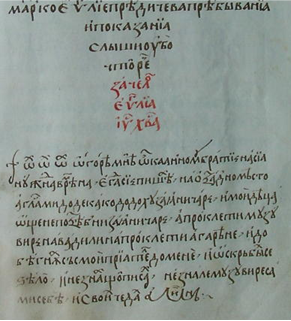
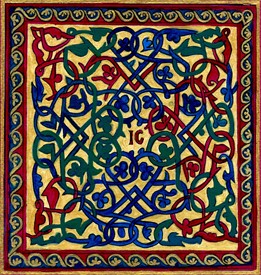
The marginalia became my doctoral dissertation topic. They reflected social marginalization and revealed a secret history of the Balkans during Ottoman rule.
This one says, ‘Oh! Oh! Oh! Pity on me…When I wrote this, hiding in the corner of the closet, they came to gather janissaries. But my children are not of the age for janissaries…’
Scribes faced so many challenges. They fought for paper, ink, and pigments -- forget about gold or gemstones! They wrote: "I froze while I was writing.” "I am writing at night, without candlelight. forgive me." Yet, they struggled on, focussing on the Word, rather than on illustrations. That is why Ottoman-era Slavic manuscripts might appear rough, naive, and less illuminated than Western manuscripts.
Illuminations and iconography then became my Orthopraxy. Icon writing starts with laying the clay for the halo, sealing the gold leaf with breath, and laying down and sealing the pigments. This process works spiritual transformation and union with God, that is, Theosis. We are the clay sealed by the Holy Spirit to receive the divine light.
The electronic treasure chest of manuscript illuminations I developed in Sofia helped me to refine, enrich, and offer them the world as part of my ministry “Sacred Illuminations”. Where paints were faded or left out, I added colors, gold, and crystals, recreating what scribes would have done with the proper materials. My first attempt at “illumination” imitated a labyrinth-like headpiece from a 16th century Gospel. Walking actual labyrinths helped people to pray, so my humble rendition leads the eye to a focal center, where resides the Sacred Name of God – XC.
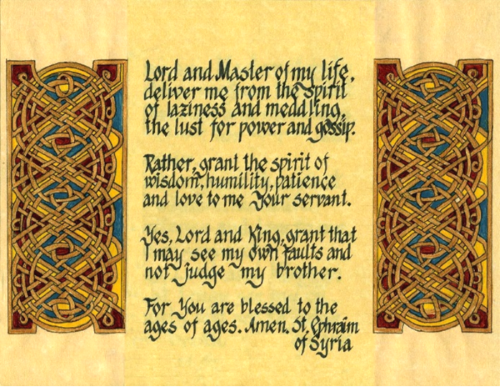
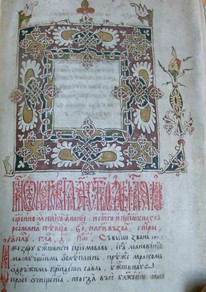
"Slavic manuscripts display an eclectic spectrum of cultural influences, Celtic, Persian, Islamic, and native woodcarvings. The floral style of illumination, featuring flowers and trees, represents the Tree of Life. It appears in the woodcarvings of the Bulgarian church iconostasis. This particular design reminds me of the Babylonian Tree of Life and inspired my illumination of 1 Cor.13 'Love is patient.'
"God blessed me to discover the manuscripts, to preserve and recreate their illuminations that inspire others to come closer to God. The poor manuscript orphans are, in fact, giants of human dignity, representing the endurance of marginalized Christians during truly oppressive times. I vow to continue the legacy of the scribes - to create new vessels for the everlasting Word of God (Matt. 9:17)."
As always we asked our Woman of the Week, Tatiana NIkolova-Houston, about her morning routine:
“Every day, I get up around 6.30-7 am. Prayer is the most important part of my morning routine. I thank God for providing me rest for my body and ask for a blessing for the day. Then I say the Jesus Prayer 40 times, bless the four corners of the world with “Holy God, Holy Mighty, Holy Immortal, have mercy on me.”
"Then, I clean up and make my bed, and stand before my home altar with more fervent prayers. St. Seraphim of Sarov’s prayer rule is a favorite of mine: say the Lord’s Prayer three times, the Prayer to the Theotokos three times, and then the prayer to the Holy Spirit three times. I also petition the Archangel Michael to protect us against our passions and the powers of evil forces, ask him to protect peace for the world, and also ask him to give common sense to our world leaders, Biden, Putin, Trump, Erdogan, Nethenyahu, and so on. I finish up with a supplication to St. Seraphim himself, that he might illumine our minds and hearts.
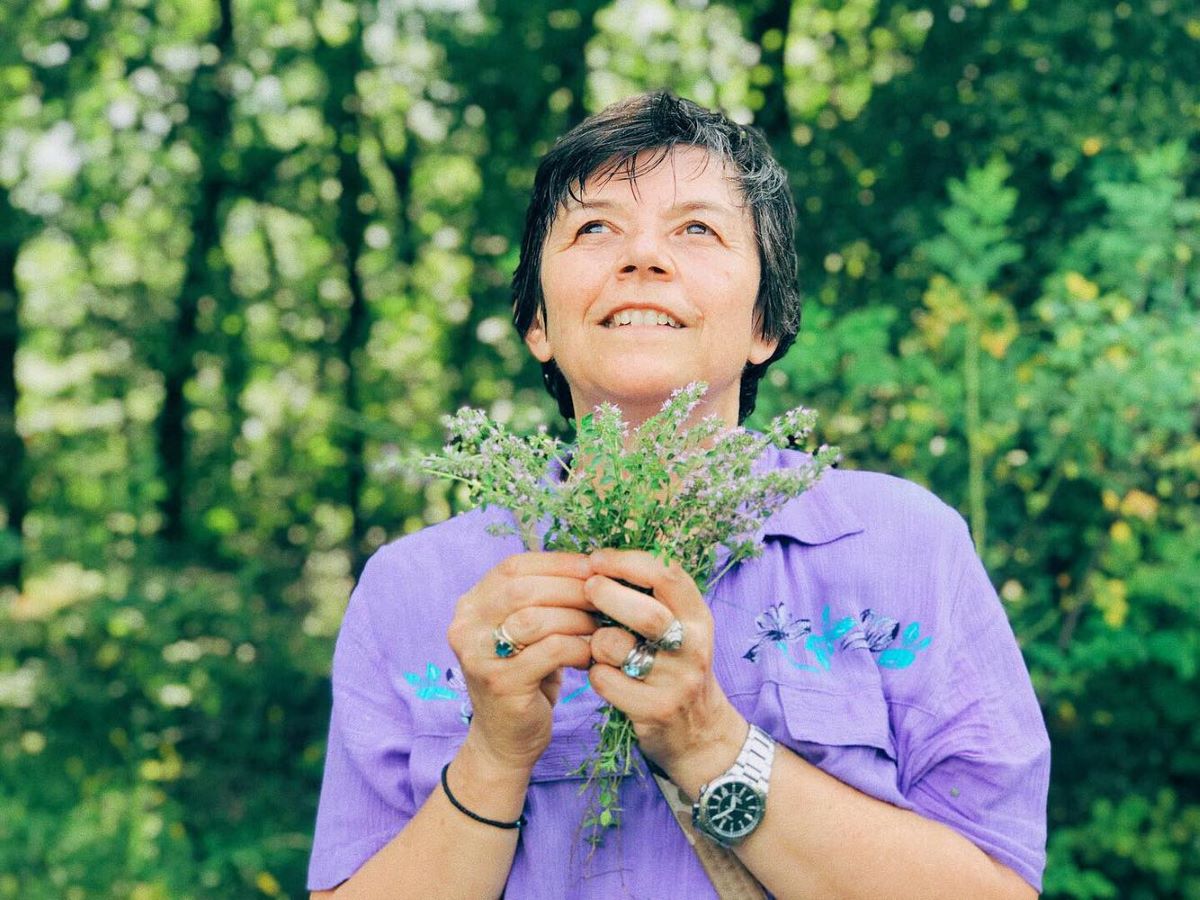
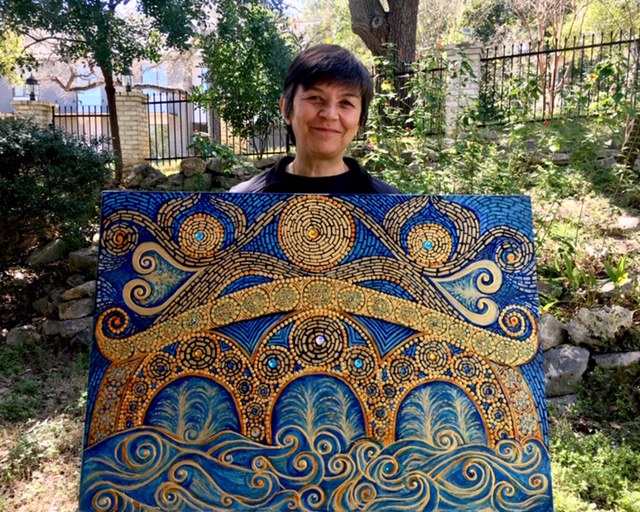
"The pandemic has caused me to reinforce these with some new prayer. For example, I’ve added a prayer that we be delivered from Covid. Bishop Basil (Essey) of Wichita, my bishop, has provided us with a wonderful prayer during the times of pandemic, which I have followed since the beginning of the pandemic. I turn to St. Nikephoros the Leper with prayers against the virus and for the healing of humankind, recalling the sick and suffering from the virus, cancer, homeless, relatives and friends, clergy and church members, with specific names of people. I finish my prayers with 40 Jesus prayers. I then anoint myself with holy oil from the sepulcher of St. John Maximovich.
"The last part of my morning routine is to head outside for a walk, so that I can rejoice in nature."
Thank you, Tatiana!


